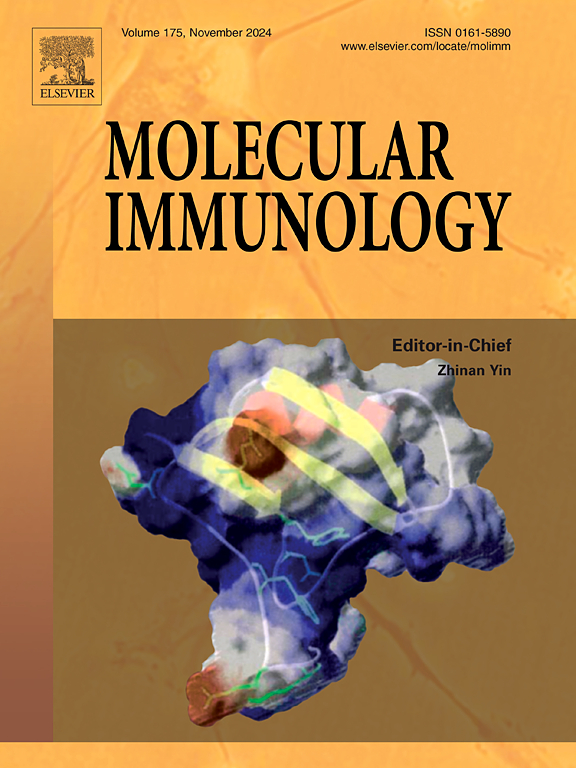金丝桃素抑制M2巨噬细胞极化,预防肝细胞癌
IF 3.2
3区 医学
Q2 BIOCHEMISTRY & MOLECULAR BIOLOGY
引用次数: 0
摘要
背景越来越多的证据表明,大多数肿瘤相关巨噬细胞中都存在对肿瘤生长至关重要的M2极化。金丝桃素是中药金丝桃的主要成分。方法用IL-4诱导骨髓源性巨噬细胞(BMDMs)分化为M2巨噬细胞,研究金丝桃素对BMDMs M2极化的影响,用RT-qPCR和流式细胞仪测定M2相关基因的mRNA水平。此外,还研究了金丝桃素预处理或不预处理的 M2 巨噬细胞(M2-CM)培养液对 Hepa1-6 细胞增殖、迁移和侵袭的影响。为了探究其机制,研究人员检测了在巨噬细胞极化过程中起关键作用的 PI3K/AKT 信号通路。结果 在本研究中,我们发现 Hyp 能显著抑制巨噬细胞的 M2 极化,表现为 CD206 和 M2 相关标志物的表达减少,此外,Hyp 还能抑制 M2-CM 诱导的 Hepa1-6 细胞的增殖、侵袭和迁移。Hyp 对 M2 巨噬细胞分化过程中的 PI3K/AKT 信号通路有抑制作用。结论 Hyp 可通过 PI3K/AKT 信号通路抑制 M2 巨噬细胞的极化,从而阻碍 HCC 的生长、增殖、侵袭和迁移。本文章由计算机程序翻译,如有差异,请以英文原文为准。
Hypericin impedes M2 macrophage polarization and protects against Hepatocellular carcinoma
Background
There has been increasing evidence that M2 polarization, which is essential for tumor growth, is present in most tumor-associated macrophages. Hypericin is the major component of the Traditional Chinese Medicine Hypericum perforatum. Hypericin exhibits antitumor activities, but its regulation on M2 macrophage polarization and the protective against Hepatocellular carcinoma (HCC) remains unknown.
Methods
IL-4 was used to induce bone marrow-derived macrophages (BMDMs) to differentiate into M2 macrophages, the effect of hypericin on M2 polarization of BMDMs was investigated, mRNA level of M2-related genes was determined using RT-qPCR and flow cytometry. Furthermore, the effect of culture medium of M2 macrophage (M2-CM) pretreated with hypericin or not on the proliferation, migration, and invasion of Hepa1–6 cells was studied. To investigate the mechanism, the PI3K/AKT signaling pathway, which is critical in macrophage polarization was tested. A mouse model of HCC was established by subcutaneous implantation of H22 cells, the impact of Hyp on tumor growth and M2 macrophage polarization in tumor tissues was identified.
Results
In the present study, we found that Hyp significantly inhibited M2 polarization of macrophages, as indicated by decreased expression of CD206 and M2-related markers, moreover, Hyp suppressed the M2-CM-induced proliferation, invasion and migration of Hepa1–6 cells. Hyp manifested an inhibitory effect on the PI3K/AKT signaling pathway during the differentiation of M2 macrophages. In vivo experiments showed that Hyp greatly suppressed tumor growth and reduced M2 macrophage polarization in tumor tissues.
Conclusion
Hyp impedes the growth, proliferation, invasion and migration of HCC by inhibiting M2 macrophages polarization via the PI3K/AKT signaling pathway, our data demonstrate that hypericin may be a promising candidate for HCC treatment.
求助全文
通过发布文献求助,成功后即可免费获取论文全文。
去求助
来源期刊

Molecular immunology
医学-免疫学
CiteScore
6.90
自引率
2.80%
发文量
324
审稿时长
50 days
期刊介绍:
Molecular Immunology publishes original articles, reviews and commentaries on all areas of immunology, with a particular focus on description of cellular, biochemical or genetic mechanisms underlying immunological phenomena. Studies on all model organisms, from invertebrates to humans, are suitable. Examples include, but are not restricted to:
Infection, autoimmunity, transplantation, immunodeficiencies, inflammation and tumor immunology
Mechanisms of induction, regulation and termination of innate and adaptive immunity
Intercellular communication, cooperation and regulation
Intracellular mechanisms of immunity (endocytosis, protein trafficking, pathogen recognition, antigen presentation, etc)
Mechanisms of action of the cells and molecules of the immune system
Structural analysis
Development of the immune system
Comparative immunology and evolution of the immune system
"Omics" studies and bioinformatics
Vaccines, biotechnology and therapeutic manipulation of the immune system (therapeutic antibodies, cytokines, cellular therapies, etc)
Technical developments.
 求助内容:
求助内容: 应助结果提醒方式:
应助结果提醒方式:


